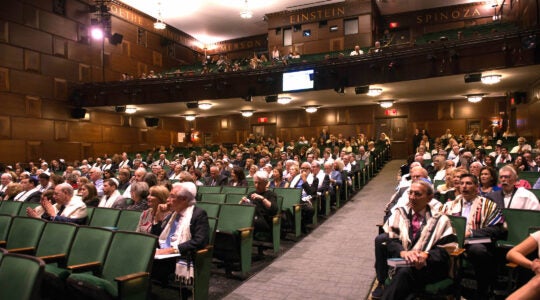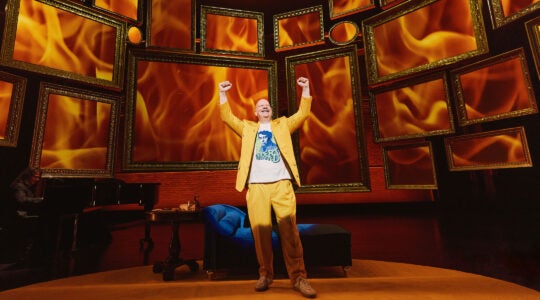One of the highlights for me of last December’s United Synagogue for Conservative Judaism (USCJ) Conference in Atlanta, which I attended in my capacity as the executive director of Beth Am Synagogue in Baltimore, was a Shabbat morning chanting service in which many of the prayers were sung to melodies of pop songs rather than traditional synagogue tunes. Singing “Oseh Shalom” to the tune of Simon and Garfunkel’s “The Sound of Silence,” I could not keep the original words to the song from overlaying the ones that I was praying. All of a sudden, calling for peace in a fractured world felt akin to visiting an elusive, shadowy spirit — “Hello darkness, my old friend, I’ve come to talk with you again…”
In an age of rapidly declining synagogue attendance among non-Orthodox Jews, particularly those in the younger generations, could incorporating more pop melodies in the liturgy help to reverse the tide? Who could resist the approach taken by Shlock Rock’s 2010 album “Shabbat in Liverpool,” in which Shabbat hymns are put to 21 different Beatles tunes?
Mind you, I’m not talking about Allan Sherman-style song parodies with clever English lyrics that recast well-known melodies with humorous Jewish references. I’m talking about keeping the Hebrew words intact, as when “D’ror Yikra” is sung to the Beach Boys’ tune, “Sloop John B,” when “Lecha Dodi” is sung to the tune of Leonard Cohen’s “Hallelujah” and “Adon Olam” is sung to the melody of — well, pretty much anything, from “The Lone Ranger” theme song to Bruce Springsteen’s “Born in the U.S.A.” to “For Forever” from “Dear Evan Hansen.” (These last two examples, as well as a collection of famous tenor arias using the same hymn, can be heard on YouTube in beautiful renditions by Cantor Avi Schwartz of Park Avenue Synagogue.)
This kind of tune appropriation can be moving, as when “Mi Chamocha” is sung to the tune of Bob Marley’s “Redemption Song,” or just plain silly, as when the same prayer is sung to the tune of “Build Me Up Buttercup” from “The Foundations.” But, as Hannah Swerdloff, Sam Whitman and Marisa Gottesman, the leaders of a 2010 United Synagogue Youth (USY) Pop Song Service in South Florida, wrote, the goal of the service was to “provide the need to actually read the Hebrew words in order to learn the new tunes; spice up the Shacharit service, [and] interest more people by using some of their favorite songs as [the] basis for prayer.”
Bonnie and Michael Levine are married singer-songwriters in Atlanta who led the Shabbat service at the USCJ Conference. Calling their group Sunmoon Pie, they bill themselves as bringing “alternative Jewish prayer melodies and meditative Hebrew kirtan-inspired chants” to synagogues in the South. Bonnie told me that pop music can be especially meaningful for those “who don’t go to shul regularly, and who see shul as different and distant from their daily life. Pop music is associated with particular times of their lives, with memories and emotions. For people who aren’t predisposed to Jewish prayer, whether they are Jewish or not, this can bridge that gap.”
Some, like Westchester-based Cantor Erik Contzius, who was trained in the Reform movement, decries the trend, which he views as trivializing the prayers. Although he conceded that chasidim teach that spirituality can be found in any melody (he has even heard of a chasidic congregation in Chicago chanting a niggun to “Jingle Bells”), Cantor Contzius said that singing the prayers to pop music suggests that “Jewish music is not good enough, that we need a gimmick. It comes from laziness on behalf of congregations and clergy.” Services are supposed to be “a dialogue between people and divine,” not merely a species of entertainment. But nowadays, he explained, “Jews don’t want to be tribalistic; they want Judaism to have a universalistic appeal.”
David Bogner, a blogger from Fairfield, Conn., who now lives in Efrat, agrees. In a 2007 blog post, he called on his ba’al tefillah (service leader) to refrain from using Andrew Lloyd Webber tunes such as “Close Every Door to Me” and “Memory” during Mussaf, along with Andrea Bocelli’s “Time to Say Goodbye,” from which, Bogner joked, the baal tefillah should take a hint.
It may, in fact, not be the millennial generation that is responding to these services as much as the baby boomers — much of the pop music that these prayers are being sung to is from the middle of the last century. Perhaps a synagogue service based on the music of Ed Sheeran or John Legend is just around the corner. If so, I’ll be there, singing along. And in the meantime, I can’t stop listening to Nili Isenberg’s haunting, interpretive version of the Mourner’s Kaddish set to Adele’s “Hello”: “Hello from the other side / I’ve said these words a thousand times.” Chanting this prayer for the thousand and first time, with a tune imported from the secular realm, reincarnates it brilliantly in a way that brings out new resonances, new associations and new meanings for our modern times.
The New York Jewish Week brings you the stories behind the headlines, keeping you connected to Jewish life in New York. Help sustain the reporting you trust by donating today.




